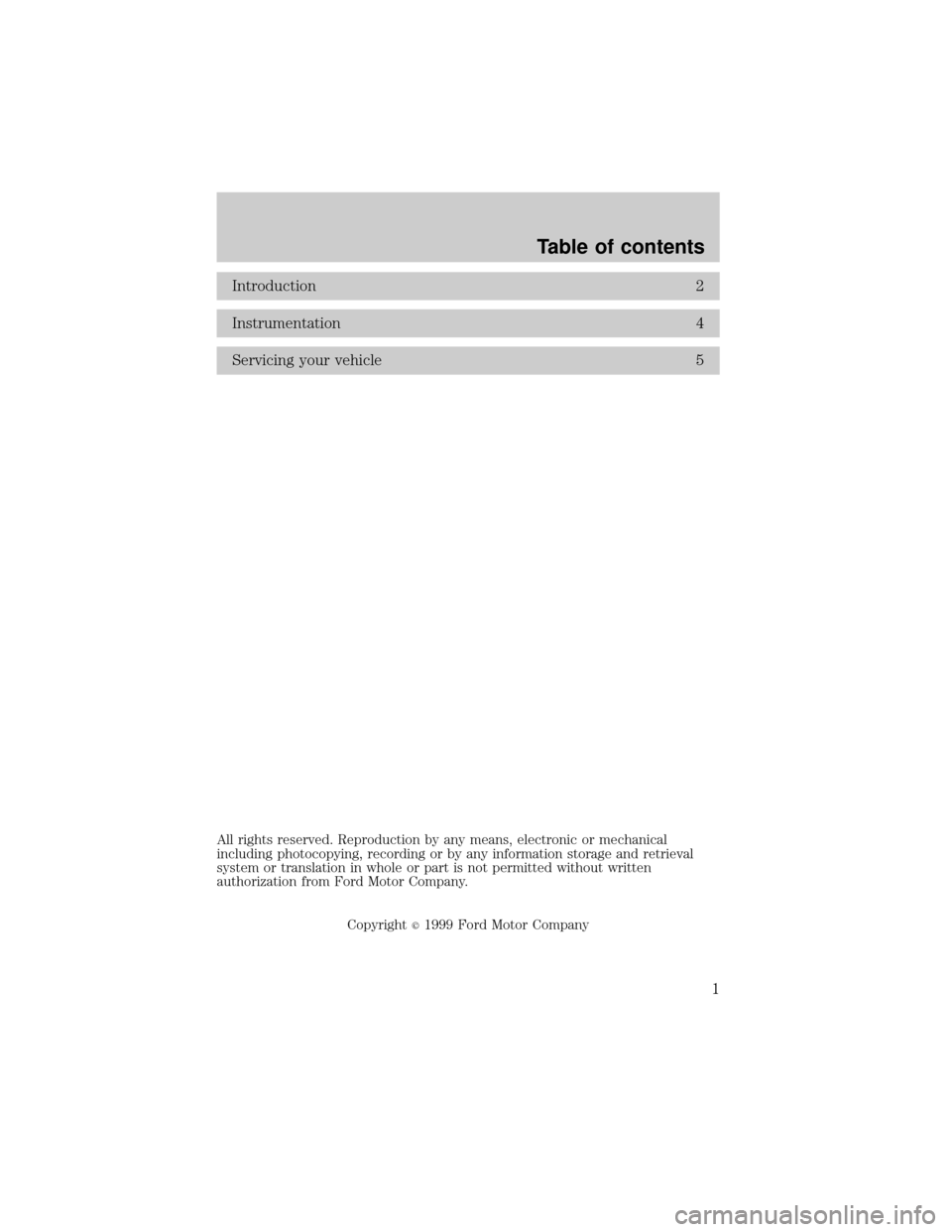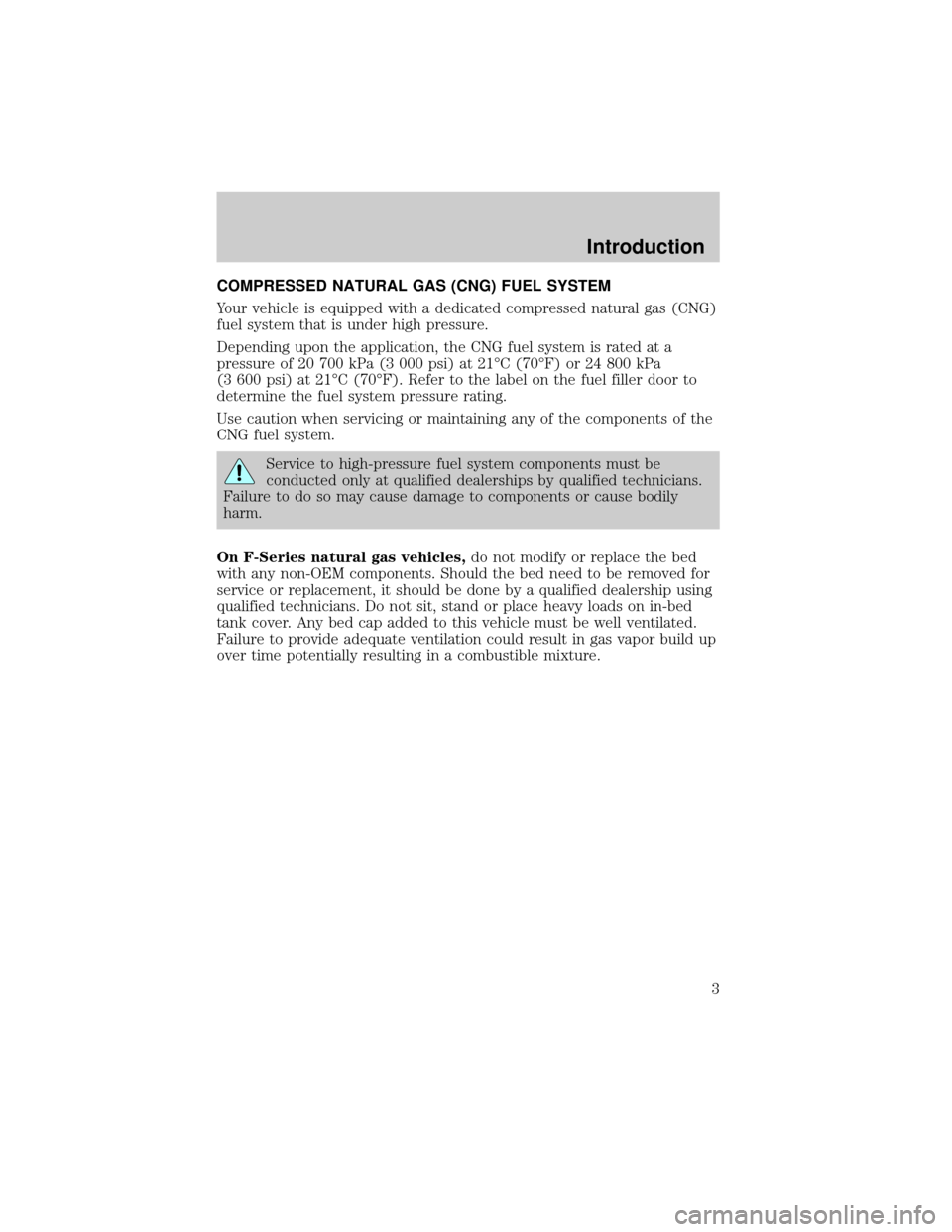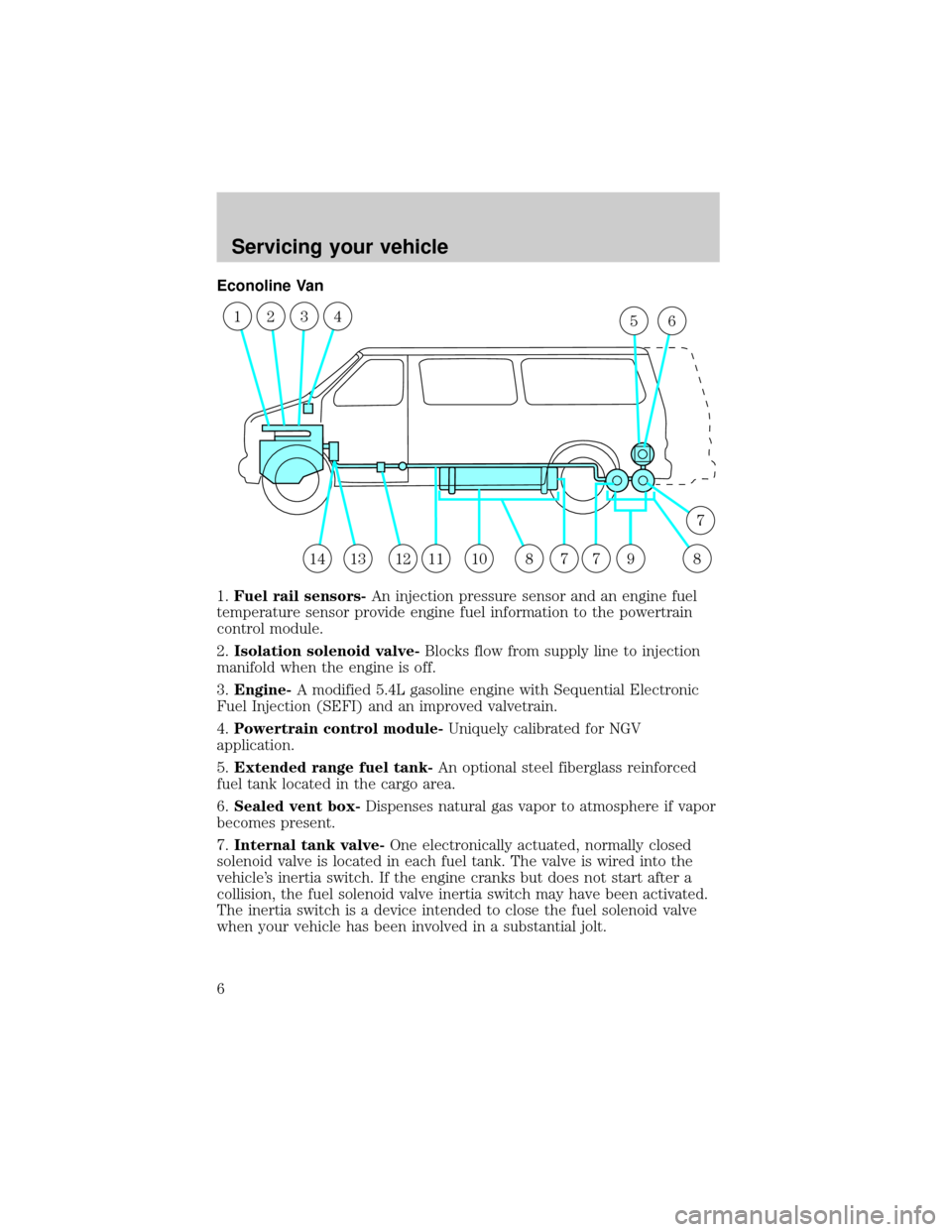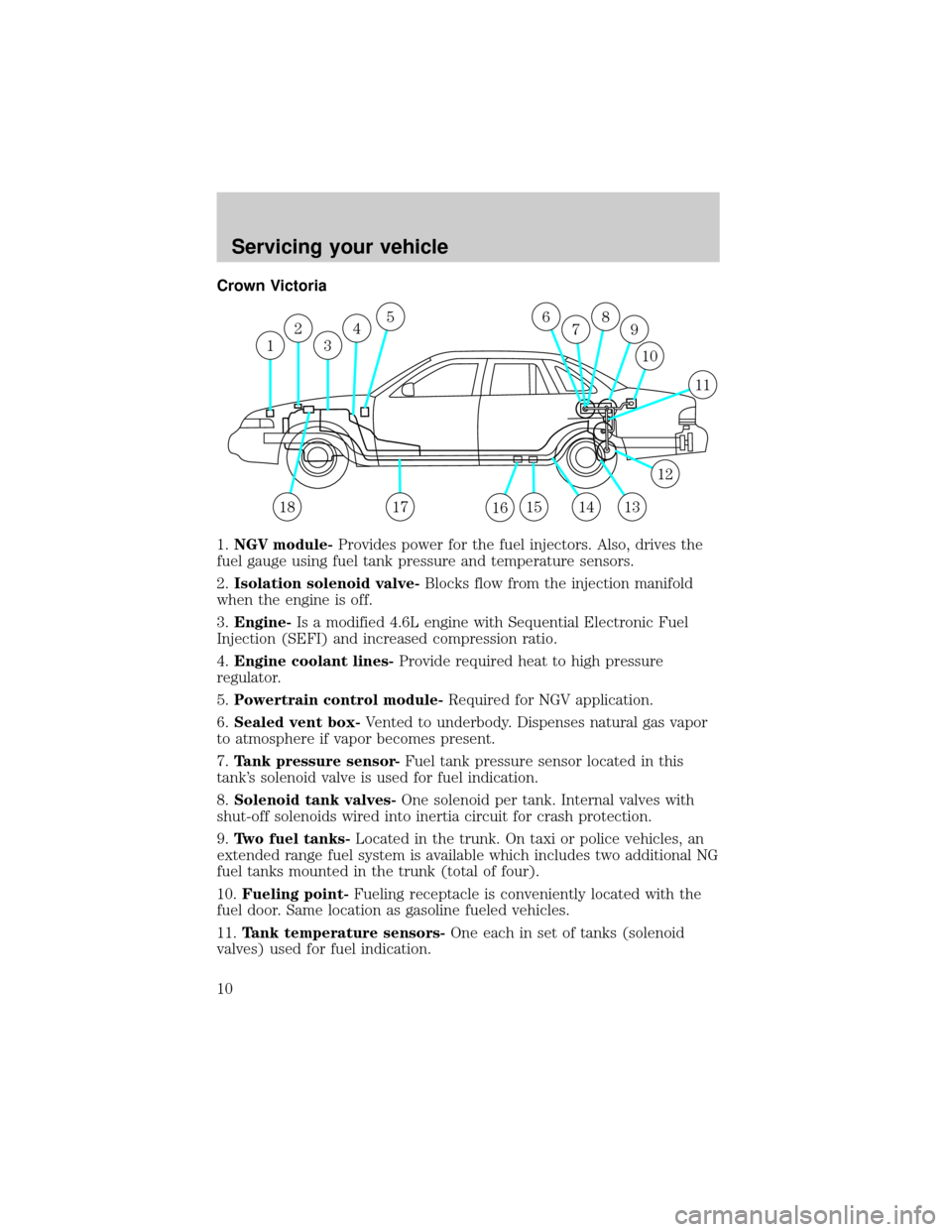FORD E SERIES 2000 4.G Natural Gas Vehicle Supplement Manual
Manufacturer: FORD, Model Year: 2000, Model line: E SERIES, Model: FORD E SERIES 2000 4.GPages: 16, PDF Size: 0.12 MB
Page 1 of 16

Introduction 2
Instrumentation 4
Servicing your vehicle 5
All rights reserved. Reproduction by any means, electronic or mechanical
including photocopying, recording or by any information storage and retrieval
system or translation in whole or part is not permitted without written
authorization from Ford Motor Company.
Copyright
r1999 Ford Motor Company
Table of contents
1
Page 2 of 16

ABOUT THIS SUPPLEMENT
This booklet supplements your Owner Guide and is part of the owner's
portfolio. It describes the operation of your natural gas vehicle (NGV)
and how it differs from a standard gasoline powered vehicle. Therefore it
is very important that you read this guide and thoroughly familiarize
yourself and others operating the vehicle with this information.
Some of the information in this supplement replaces certain instructions
in the Owner Guide. Please read this supplement carefully and
completely. Refer to the Owner Guide for complete vehicle information.
WARNINGS
Warnings remind you to be especially careful in those areas of the
vehicle where carelessness can cause damage to your vehicle or possible
personal injury to yourself, your passengers or others. Please read all
warnings carefully.
ABOUT THE WARRANTIES
The normal vehicle warranties will apply to your NGV. For further
information, refer to your Warranty Information Booklet.
Specified maintenance procedures must be followed. Repairs must be
made by trained personnel.
It is important that your NGV be properly maintained by qualified Ford
trained gaseous fuel service technicians. If a problem occurs, it is
important that properly trained personnel diagnose and repair the cause.
If the problem relates to the fuel system, proper part replacement is
imperative to keep your vehicle operating correctly. NGV fuel system
components and standard gasoline fuel system components are not
interchangeable. If your NGV is not maintained in accordance with
approved service procedures, damage may occur and your warranty may
be invalidated.
Any modification to the fuel system of your NGV voids the Ford New
Vehicle Limited Warranty.
Introduction
2
Page 3 of 16

COMPRESSED NATURAL GAS (CNG) FUEL SYSTEM
Your vehicle is equipped with a dedicated compressed natural gas (CNG)
fuel system that is under high pressure.
Depending upon the application, the CNG fuel system is rated at a
pressure of 20 700 kPa (3 000 psi) at 21ÉC (70ÉF) or 24 800 kPa
(3 600 psi) at 21ÉC (70ÉF). Refer to the label on the fuel filler door to
determine the fuel system pressure rating.
Use caution when servicing or maintaining any of the components of the
CNG fuel system.
Service to high-pressure fuel system components must be
conducted only at qualified dealerships by qualified technicians.
Failure to do so may cause damage to components or cause bodily
harm.
On F-Series natural gas vehicles,do not modify or replace the bed
with any non-OEM components. Should the bed need to be removed for
service or replacement, it should be done by a qualified dealership using
qualified technicians. Do not sit, stand or place heavy loads on in-bed
tank cover. Any bed cap added to this vehicle must be well ventilated.
Failure to provide adequate ventilation could result in gas vapor build up
over time potentially resulting in a combustible mixture.
Introduction
3
Page 4 of 16

FUEL GAUGE
The fuel gauge in your NGV behaves similarly to a typical gasoline fuel
gauge. However, the gauge operation is based on the pressure and
temperature of the natural gas, not on the level of liquid gasoline.
Depending upon application, a fuel gauge reading of Full will occur at a
pressure of approximately 20 700 kPa (3 000 psi) or 24 800 kPa
(3 600 psi), at a temperature of approximately 21ÉC (70ÉF). The NGV
fuel gauge will provide a linear reading from this point down to Empty.
Refer to theFuelingsection of this supplement for more information on
fuel gauge performance during the fast-fill method of fueling.
Instrumentation
4
Page 5 of 16

CNG FUEL SYSTEM COMPONENT IDENTIFICATION
The following illustrations depict the major unique components of the
CNG fuel system. All of these unique components are constructed of
special materials that withstand the effects of CNG.NEVERreplace a
unique CNG fuel system component with a standard gasoline fuel system
component or any aftermarket component.
Servicing your vehicle
5
Page 6 of 16

Econoline Van
1.Fuel rail sensors-An injection pressure sensor and an engine fuel
temperature sensor provide engine fuel information to the powertrain
control module.
2.Isolation solenoid valve-Blocks flow from supply line to injection
manifold when the engine is off.
3.Engine-A modified 5.4L gasoline engine with Sequential Electronic
Fuel Injection (SEFI) and an improved valvetrain.
4.Powertrain control module-Uniquely calibrated for NGV
application.
5.Extended range fuel tank-An optional steel fiberglass reinforced
fuel tank located in the cargo area.
6.Sealed vent box-Dispenses natural gas vapor to atmosphere if vapor
becomes present.
7.Internal tank valve-One electronically actuated, normally closed
solenoid valve is located in each fuel tank. The valve is wired into the
vehicle's inertia switch. If the engine cranks but does not start after a
collision, the fuel solenoid valve inertia switch may have been activated.
The inertia switch is a device intended to close the fuel solenoid valve
when your vehicle has been involved in a substantial jolt.
13
321456
1114101298877
7
Servicing your vehicle
6
Page 7 of 16

8.Stone shield(s)-Protective shield(s) to prevent damage to the fuel
tank(s) caused by road debris or other road hazards.
9.Aft axle fuel tanks-Two steel fiberglass reinforced fuel tanks
located behind the rear axle.
10.Midship fuel tank-A steel fiberglass reinforced fuel tank located
underbody.
11.High pressure fuel lines-Delivers high pressure fuel to the fuel
tanks and fuel pressure regulator.
12.Fuel pressure regulator/Coalescent fuel filter-Reduces fuel
pressure to 95 psi and removes impurities from the gas.
13.Low pressure fuel line-Supplies 95 psi of natural gas to the
injectors.
14.NGV module-Contains the unique powertrain electronics that are
required for an NGV.
Servicing your vehicle
7
Page 8 of 16

F-Series Pick-up
1.Fuel rail sensors-An injection pressure sensor and an engine fuel
temperature sensor provide engine fuel information to the powertrain
control module.
2.Isolation solenoid valve-Blocks flow from supply line to injection
manifold when the engine is off.
3.Engine-A modified 5.4L gasoline engine with Sequential Electronic
Fuel Injection (SEFI) and an improved valvetrain.
4.Powertrain control module-Uniquely calibrated for NGV
application.
5.Internal tank valve-One electronically actuated, normally closed
solenoid valve is located in each fuel tank. The valve is wired into the
vehicle's inertia switch. If the engine cranks but does not start after a
collision, the fuel solenoid valve inertia switch may have been activated.
The inertia switch is a device intended to close the fuel solenoid valve
when your vehicle has been involved in a substantial jolt.
6.Standard fuel tanks-Two steel fiberglass reinforced fuel tanks
located in the bed of the truck.
6b.In-bed tank cover-Cover to prevent damage to the fuel tanks.
Protective shield to prevent damage to the fuel tank caused by road
12
324156
109811
6b
7
5
Servicing your vehicle
8
Page 9 of 16

debris or other road hazards.Do not sit, stand or place heavy loads
on the fuel tank cover.
7.Stone shield-Protective shield to prevent damage to the fuel tank
caused by road debris or other road hazards.
8.Optional fuel tank-A steel fiberglass reinforced fuel tank located
underbody.
9.High pressure fuel lines-Delivers high pressure fuel to the fuel
tanks and fuel pressure regulator.
10.Fuel pressure regulator/Coalescent fuel filter-Reduces fuel
pressure to 95 psi and removes impurities from the gas.
11.Low pressure fuel line-Supplies 95 psi of natural gas to the
injectors.
12.NGV module-Contains the unique powertrain electronics that are
required for an NGV.
Servicing your vehicle
9
Page 10 of 16

Crown Victoria
1.NGV module-Provides power for the fuel injectors. Also, drives the
fuel gauge using fuel tank pressure and temperature sensors.
2.Isolation solenoid valve-Blocks flow from the injection manifold
when the engine is off.
3.Engine-Is a modified 4.6L engine with Sequential Electronic Fuel
Injection (SEFI) and increased compression ratio.
4.Engine coolant lines-Provide required heat to high pressure
regulator.
5.Powertrain control module-Required for NGV application.
6.Sealed vent box-Vented to underbody. Dispenses natural gas vapor
to atmosphere if vapor becomes present.
7.Tank pressure sensor-Fuel tank pressure sensor located in this
tank's solenoid valve is used for fuel indication.
8.Solenoid tank valves-One solenoid per tank. Internal valves with
shut-off solenoids wired into inertia circuit for crash protection.
9.Two fuel tanks-Located in the trunk. On taxi or police vehicles, an
extended range fuel system is available which includes two additional NG
fuel tanks mounted in the trunk (total of four).
10.Fueling point-Fueling receptacle is conveniently located with the
fuel door. Same location as gasoline fueled vehicles.
11.Tank temperature sensors-One each in set of tanks (solenoid
valves) used for fuel indication.
13
2456879
10
11
12
131415171816
Servicing your vehicle
10